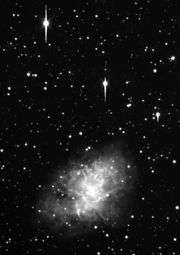19 Fortuna
 Fortuna centered above the Crab Nebula | |
| Discovery | |
|---|---|
| Discovered by | John Russell Hind |
| Discovery date | August 22, 1852 |
| Designations | |
| MPC designation | (19) Fortuna |
| Pronunciation | /fɔːrˈtjuːnə/ |
Named after | Fortūna |
| A902 UG | |
| Main belt | |
| Orbital characteristics[1] | |
| Epoch October 22, 2004 (JD 2453300.5) | |
| Aphelion | 2.831 AU (423.443 Gm) |
| Perihelion | 2.052 AU (307.028 Gm) |
| 2.441 AU (365.235 Gm) | |
| Eccentricity | 0.159 |
| 3.81 a (1393.378 d) | |
Average orbital speed | 18.94 km/s |
| 268.398° | |
| Inclination | 1.573° |
| 211.379° | |
| 182.091° | |
| Physical characteristics | |
| Dimensions |
(225×205×195)±12 km[2] 225 km[3][4] |
| Mass | 1.27×1019 kg[2] |
Mean density | 2.70±0.48 g/cm³[2] |
Equatorial surface gravity | ~0.0629 m/s² |
Equatorial escape velocity | ~0.1190 km/s |
| 0.3101 d (7.4432 h)[1] | |
| 0.037[1] | |
| Temperature | ~180 K |
| G[1] | |
| 8.88[5] to 12.95 | |
| 7.13[1] | |
| 0.25" to 0.072" | |
|
| |
19 Fortuna is one of the largest main-belt asteroids. It has a composition similar to 1 Ceres: a darkly colored surface that is heavily space-weathered with the composition of primitive organic compounds, including tholins.
Fortuna is 225 km in diameter and has one of the darkest known geometric albedos for an asteroid over 150 km in diameter. Its albedo has been measured at 0.028 and 0.037.[6] The spectra of the asteroid displays evidence of aqueous alteration.[7]
The Hubble Space Telescope observed Fortuna in 1993. It was resolved with an apparent diameter of 0.20 arcseconds (4.5 pixels in the Planetary Camera) and its shape was found to be nearly spherical. Satellites were searched for but none were detected.
Stellar occultations by Fortuna have been observed several times. Fortuna has been studied by radar.[8]
It was discovered by J. R. Hind on August 22, 1852, and named after Fortuna, the Roman goddess of luck.
Fortuna has been perturbed by the 80 km 135 Hertha and was initially estimated by Baer to have a mass of 1.08×1019 kg.[4] A more recent estimate by Baer suggests it has a mass of 1.27×1019 kg.[2]
On December 21, 2012 Fortuna (~200 km) harmlessly passed within 6.5Gm of asteroid 687 Tinette.[9]
References
- 1 2 3 4 5 "JPL Small-Body Database Browser: 19 Fortuna" (2008-08-21 last obs). Retrieved 2008-11-11.
- 1 2 3 4 Jim Baer (2008). "Recent Asteroid Mass Determinations". Personal Website. Retrieved 2008-11-27.
- ↑ Storrs, Alex; Weiss, B.; Zellner, B.; et al. (1998). "Imaging Observations of Asteroids with Hubble Space Telescope" (PDF). Icarus. 137 (2): 260–268. Bibcode:1999Icar..137..260S. doi:10.1006/icar.1999.6047. Archived from the original (PDF) on February 25, 2012. Retrieved January 15, 2005.
- 1 2 Baer, James; Steven R. Chesley (2008). "Astrometric masses of 21 asteroids, and an integrated asteroid ephemeris" (PDF). Celestial Mechanics and Dynamical Astronomy. Springer Science+Business Media B.V. 2007. 100 (2008): 27–42. Bibcode:2008CeMDA.100...27B. doi:10.1007/s10569-007-9103-8. Retrieved 2008-11-11.
- ↑ "AstDys (19) Fortuna Ephemerides". Department of Mathematics, University of Pisa, Italy. Retrieved 2010-06-27.
- ↑ Storrs, Alex; Dunne; Conan; Mugnier; et al. (2005). "A closer look at main belt asteroids 1: WF/PC images" (PDF). Icarus. 173 (2): 409–416. Bibcode:2005Icar..173..409S. doi:10.1016/j.icarus.2004.08.007. Archived from the original (PDF) on April 18, 2007. Retrieved 2007-09-23.
- ↑ Fornasier, S.; et al. (February 1999), "Spectroscopic comparison of aqueous altered asteroids with CM2 carbonaceous chondrite meteorites", Astronomy and Astrophysics Supplement, 135: 65−73, Bibcode:1999A&AS..135...65F, doi:10.1051/aas:1999161.
- ↑ "Radar-Detected Asteroids and Comets". NASA/JPL Asteroid Radar Research. Retrieved 2011-10-30.
- ↑ Generated with Solex 10 Archived April 29, 2009, at WebCite by Aldo Vitagliano
External links
- 19 Fortuna at AstDyS-2, Asteroids—Dynamic Site
- 19 Fortuna at the JPL Small-Body Database
